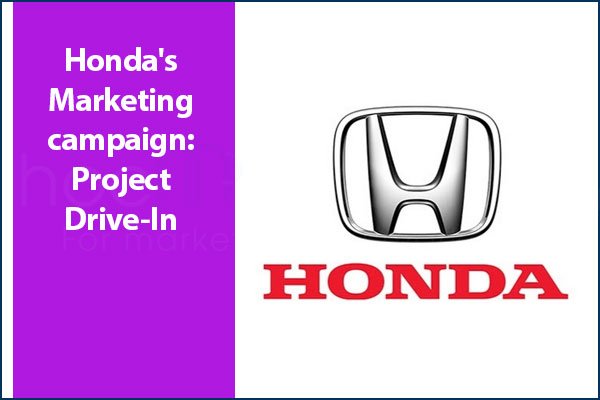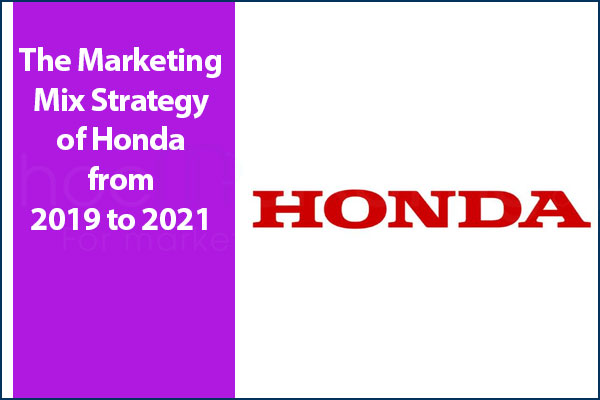
Honda's Marketing campaign: Project Drive-In

Welcome to our blog post about Honda's "Project Drive-In" Marketing Campaign. This campaign was launched by Honda in 2013 to preserve drive-in theaters across the United States. As the popularity of drive-ins dwindled, Honda recognized the cultural significance of these theaters and wanted to help keep them alive.
Welcome to our blog post about Honda's "Project Drive-In" Marketing Campaign. This campaign was launched by Honda in 2013 to preserve drive-in theaters across the United States. As the popularity of drive-ins dwindled, Honda recognized the cultural significance of these theaters and wanted to help keep them alive. The campaign was a huge success and received a lot of attention from both the media and the public. In this post, we'll dive into the details of the campaign, including its objective, implementation, results, and overall review. So, let's get started!
About Honda's "Project Drive-In" Marketing Campaign
Honda's "Project Drive-In" Marketing Campaign was launched in 2013 with the objective of preserving America's dying drive-in movie theaters. Honda, a leading automobile manufacturer, took on this initiative as a way to give back to the communities where it operates. The campaign was developed in response to the fact that many drive-in theaters were facing closure due to the high costs of converting to digital projection.
The "Project Drive-In" campaign aimed to raise awareness about the issue and encourage people to support their local drive-in theaters. Honda invited people to vote for their favorite drive-in theater on the campaign website, and the top five theaters received digital projectors from Honda.
The campaign was a huge success, with over 2.6 million votes cast and more than 50,000 people signing up to support their local drive-in theaters. Honda also received widespread media coverage, with articles appearing in top publications like Forbes and The New York Times.
Overall, Honda's "Project Drive-In" Marketing Campaign was an innovative and effective way to support local communities and preserve a beloved American pastime. It demonstrated Honda's commitment to social responsibility and creative marketing strategies.
The Objective of Honda's "Project Drive-In" Marketing Campaign
The objective of Honda's "Project Drive-In" Marketing Campaign was to preserve and celebrate the American drive-in theater culture. As many drive-in theaters were facing closure due to the high costs of converting to digital projection, Honda aimed to raise awareness about this issue and provide a solution.
Honda set a goal to save as many drive-ins as possible by encouraging people to vote for their favorite drive-in theater to receive a digital projector. The company also pledged to donate five projectors to the cause.
In addition to preserving a beloved part of American culture, Honda's objective for this campaign was to build brand awareness and loyalty. By aligning with a cause that resonated with their target audience, Honda was able to create a positive brand image and increase engagement with their brand.
Overall, the objective of Honda's "Project Drive-In" Marketing Campaign was to make a difference in the lives of Americans while also strengthening their brand reputation.
How to implement Honda's "Project Drive-In" Marketing Campaign
Section 3: How to Implement Honda's "Project Drive-In" Marketing Campaign
Implementing Honda's "Project Drive-In" marketing campaign requires careful planning and execution. The campaign is geared towards preserving a part of American history by saving drive-in theaters from going out of business due to the shift to digital projection technology. Here's how you can implement the campaign:
1. Identify drive-in theaters in your area
The first step is to identify drive-in theaters in your area that are facing closure. You can do this by conducting a quick online search, contacting local media outlets, or reaching out to community groups that support the preservation of drive-in theaters.
2. Contact the owners of the drive-in theaters
Once you have identified the theaters, reach out to the owners and explain the purpose of the campaign. Share the details of Honda's initiative and how they can benefit from it. Encourage them to sign up for the campaign on the official website.
3. Spread the word
Use social media platforms such as Facebook, Twitter, and Instagram to spread the word about the campaign. Share the official website link and encourage people to sign up to support their local drive-in theaters.
4. Host fundraising events
Consider hosting fundraising events to support the campaign. You can organize a movie night at the drive-in theater or a car show to raise funds.
5. Engage with the community
Engage with the local community to rally support for the campaign. You can collaborate with local businesses to offer discounts to people who sign up for the campaign or sponsor a community event to raise awareness.
6. Monitor progress
Keep track of the progress of the campaign by monitoring the number of sign-ups on the official website. Encourage people to continue supporting the campaign even after their local theater has been saved.
In conclusion, implementing Honda's "Project Drive-In" marketing campaign requires a strategic approach that involves identifying drive-in theaters, reaching out to owners, spreading the word, hosting events, engaging with the community, and monitoring progress. By following these steps, you can help save a part of American history and preserve the tradition of drive-in theaters for future generations.
Results from Honda's "Project Drive-In" Marketing Campaign
Honda's "Project Drive-In" campaign was a huge success, generating widespread media coverage and positive sentiment. The campaign received over 2.6 million page views on the Project Drive-In website and over 5.5 million video views on YouTube. Honda's social media channels also experienced a surge in engagement, with over 70,000 Facebook likes and 10,000 Twitter followers.
The results of the campaign were not limited to digital metrics, as Honda also saw a significant increase in attendance at drive-in theaters across the United States. According to Honda, over 120,000 people attended Project Drive-In events, and over 350,000 people signed petitions to save drive-in theaters.
The campaign also had a positive impact on Honda's brand perception, with many consumers expressing admiration for the company's commitment to preserving an American cultural icon. Honda's efforts to save drive-in theaters resonated with consumers, who appreciated the company's dedication to supporting local communities and preserving a unique form of entertainment.
Overall, Honda's "Project Drive-In" campaign was a resounding success, generating positive media coverage, increasing attendance at drive-in theaters, and improving the company's brand perception. The campaign demonstrated the power of creative marketing strategies and the importance of supporting local communities.
Review of Honda's "Project Drive-In" Marketing Campaign.
After analyzing the results of Honda's "Project Drive-In" marketing campaign, it's clear that the initiative was a huge success. The campaign was able to generate a lot of buzz and garner a significant amount of media attention.
One of the most impressive aspects of the campaign was the way it resonated with consumers. By tapping into a sense of nostalgia and promoting the importance of preserving a piece of Americana, Honda was able to connect with people on an emotional level.
In addition to the emotional appeal, the campaign was also successful from a business standpoint. By partnering with local communities and leveraging social media, Honda was able to drive significant foot traffic to its dealerships. As a result, the campaign helped to boost sales and increase brand awareness.
However, there were some areas where the campaign could have been improved. For example, the initiative was primarily focused on drive-in theaters in rural areas, which may have limited its reach to urban consumers. Additionally, while the campaign was successful in generating buzz and driving traffic, it remains to be seen whether it will have a long-term impact on Honda's bottom line.
Overall, Honda's "Project Drive-In" marketing campaign was a creative and effective way to promote the brand while also supporting a worthy cause. By tapping into consumers' emotions and leveraging social media, Honda was able to generate significant buzz and drive sales. While there were some areas for improvement, the campaign was definitely a step in the right direction for the automotive giant.
Summary
In conclusion, Honda's "Project Drive-In" marketing campaign was a huge success. It not only helped preserve a part of American history but also created a buzz in the market and increased brand awareness. The objective of the campaign was to raise awareness about the plight of drive-in theaters and encourage people to visit them. Through the use of social media and innovative marketing strategies, Honda was able to achieve its objective and help drive-in theaters across the country. The results were impressive, with over 2.5 million votes and a total of $100,000 in donations. The success of this campaign is a testament to Honda's commitment to sustainability, innovation, and community involvement. Overall, Honda's Project Drive-In campaign serves as a great example of how a well-executed marketing campaign can make a positive impact on society while also benefiting the brand.














